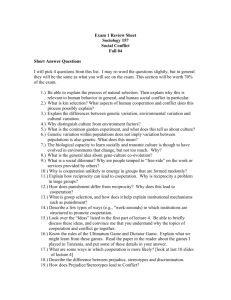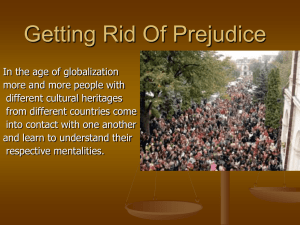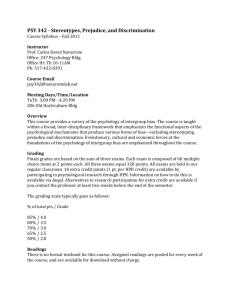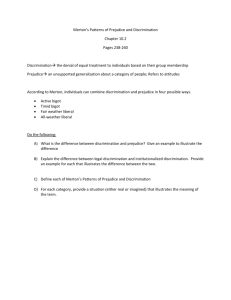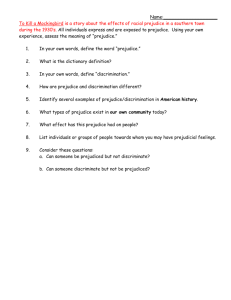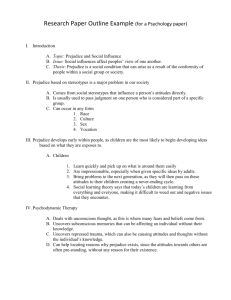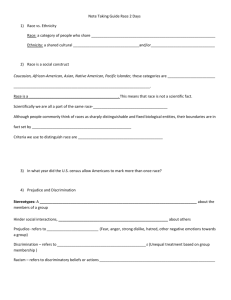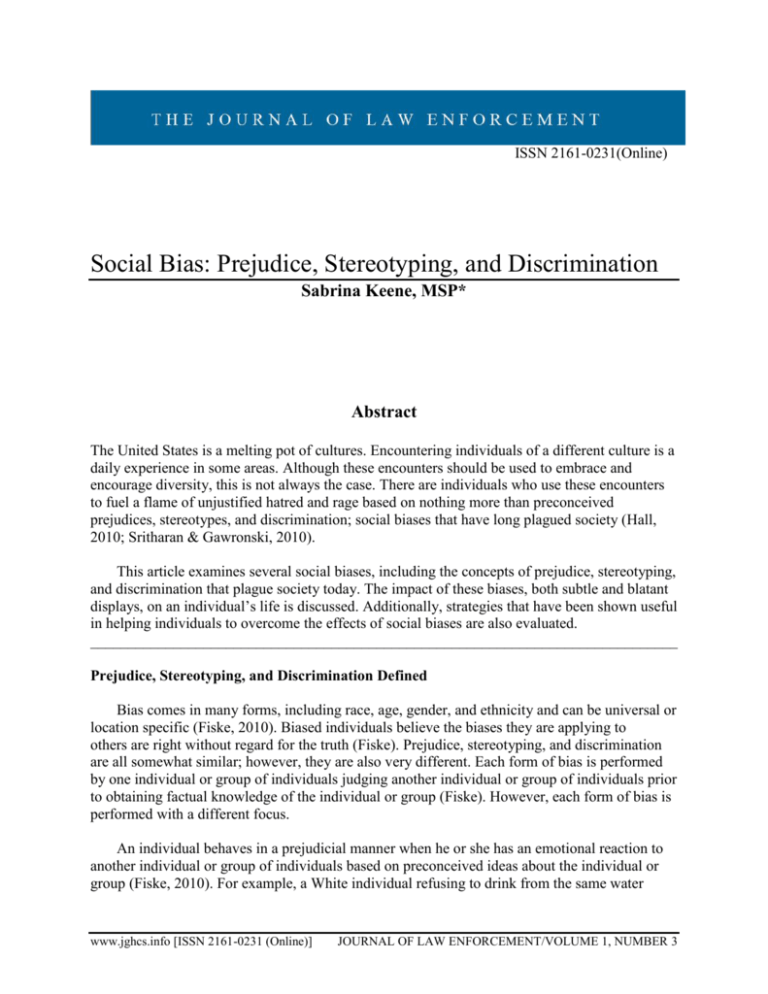
ISSN 2161-0231(Online)
Social Bias: Prejudice, Stereotyping, and Discrimination
Sabrina Keene, MSP*
Abstract
The United States is a melting pot of cultures. Encountering individuals of a different culture is a
daily experience in some areas. Although these encounters should be used to embrace and
encourage diversity, this is not always the case. There are individuals who use these encounters
to fuel a flame of unjustified hatred and rage based on nothing more than preconceived
prejudices, stereotypes, and discrimination; social biases that have long plagued society (Hall,
2010; Sritharan & Gawronski, 2010).
This article examines several social biases, including the concepts of prejudice, stereotyping,
and discrimination that plague society today. The impact of these biases, both subtle and blatant
displays, on an individual’s life is discussed. Additionally, strategies that have been shown useful
in helping individuals to overcome the effects of social biases are also evaluated.
______________________________________________________________________________
Prejudice, Stereotyping, and Discrimination Defined
Bias comes in many forms, including race, age, gender, and ethnicity and can be universal or
location specific (Fiske, 2010). Biased individuals believe the biases they are applying to
others are right without regard for the truth (Fiske). Prejudice, stereotyping, and discrimination
are all somewhat similar; however, they are also very different. Each form of bias is performed
by one individual or group of individuals judging another individual or group of individuals prior
to obtaining factual knowledge of the individual or group (Fiske). However, each form of bias is
performed with a different focus.
An individual behaves in a prejudicial manner when he or she has an emotional reaction to
another individual or group of individuals based on preconceived ideas about the individual or
group (Fiske, 2010). For example, a White individual refusing to drink from the same water
www.jghcs.info [ISSN 2161-0231 (Online)]
JOURNAL OF LAW ENFORCEMENT/VOLUME 1, NUMBER 3
Social Biases: Prejudice, Stereotyping, and Discrimination/Keene | 2
fountain as a Black individual based solely on racial bias represents prejudice by the White
individual. The White individual has no factual information to support not drinking from the
same water fountain; however, he or she has a preconceived idea of the Black individual and
therefore refuses to use the same drinking fountain.
According to Fiske (2010), stereotyping is the application of an individual’s own thoughts,
beliefs, and expectations onto other individuals without first obtaining factual knowledge about
the individual(s). Many times, stereotypes are created after multiple occurrences of a similar
experience. For example, an individual that knows several individuals, or families, from the
south and that enjoy sweet potato pie, could lead that individual to the belief, or geographical
stereotype that all families in the south enjoy sweet potato pie.
Discrimination is the denial of equal rights based on prejudices and stereotypes (Fiske,
2010). Discrimination differs from prejudice and stereotyping, in that it is not a belief, but rather
the application of beliefs (Fiske, 2010). An example of discrimination is a female not getting a
job because the hiring manager wanted a male to fill the position.
Differences between Subtle and Blatant Bias
Although it is understood that bias is biased, it is essential to highlight the differences in the
presentation of biases. Subtle biases, for example, are not displayed forcefully (Sritharan &
Gawronski, 2010). An individual may appear to be unbiased and even consider him or herself to
be unbiased. However, when an issue becomes personal he or she is likely to have at least slight
preferences on the matter (Fiske, 2010; Sritharan & Gawronski). For example, while most
Americans believe public schools should be integrated, a portion of the population is
uncomfortable with interracial marriage. These subtle biases can remain dormant or even
undetected, but this does not mean they do not exist.
Adversely, blatant biases are not deniable (Sritharan & Gawronski, 2010). These biases are
displayed for the world to see. Blatant biases announce an individual’s displeasure with someone
or something. These biases are founded on the core social motive of belonging (Fiske, 2010). In
order to fit in with the “in” group, individuals must display the same beliefs as the group, no
matter who is hurt by the display (Fiske). An example of blatant bias are hate crimes; an
individual causing harm to another individual because he or she is of a different race, gender,
sexual orientation, or social status. The perpetrator displays dislike or prejudice against the
victim for the world to see, without regard for the victim and believes he or she is justified in his
or her actions (Fiske).
Impact of Bias on the Lives of Individuals
Biases impact not only the victim of the bias, but also every individual who witnesses the
bias as well as the perpetrator (Rivers, Poteat, Noret, & Ashurst, 2009). It takes a strong
individual to stand tall in the face of adversity. Individuals who fall victim to prejudices,
stereotypes, and discrimination do so in various ways; some succumb to depression and
withdrawal, while others give in to the stereotypes, often believing the stereotypes placed against
them or others (Rivers, et al.). While it is understandable how prejudice, stereotypes, and
www.jghcs.info [ISSN 2161-0231 (Online)]
JOURNAL OF LAW ENFORCEMENT/VOLUME 1, NUMBER 3
Social Biases: Prejudice, Stereotyping, and Discrimination/Keene | 3
discrimination can lead an individual to low self-esteem, mental breakdowns, depression, and
other lows, this is not always the outcome (Sinclair & Kunda, 1999).
Individuals who do not fall victim to bias are often able use such circumstances as
motivating factors (Sinclair & Kunda, 1999). What was intended to hurt, degrade, belittle, and
flat out stop these individuals, actually propels them forward. These individuals may suffer from
moments of negativity, but they only give brief moments to the negative desires which could
consume them. Individuals who are strong enough to overcome adversity are often driven by a
desire to prove the stereotypes wrong (Fiske, 2010).
Overcoming Social Biases
Individuals are often afraid of what they do not know. The best defense against ignorance is
knowledge. Education and familiarization with the object of a prejudice or stereotype allows the
truth to be discovered and applied (Fowers & Richardson, 1996; Rudman, Ashmore, & Gary,
2001). Being educated allows an individual the ability to embrace and accept differences in
others, and aids in bringing society together (Plant & Devine, 2009). Arming individuals with
knowledge and information can ease the burden of not knowing. Possessing the truth can defend
against the prejudices, stereotypes, and discriminations that plague today’s society (Plant &
Devine).
One way for an individual to conquer a prejudice or stereotype is to spend time with the
individuals he or she is stereotyping (Fowers & Richardson, 1996; Tausch & Hewstone, 2010).
Spending time with these individuals allows both groups to begin to understand and to know the
individual on a more personal level. This may also make individuals who stereotype others less
likely to do so in the future if they find the stereotype to be false (Fowers & Richardson).
Scholarly research is another way individuals can use to reduce or eliminate stereotypes. If
an individual were to ask friends or family members about a prejudice or stereotype he or she
would likely get more opinionate responses and less factual evidence to support or debunk the
prejudice or stereotype (Tausch & Hewstone, 2010). For this reason, taking the time to research
the prejudice or stereotype can prove most beneficial to an individual who desires to find the
truth and change.
Change can be rewarding, however, it can also be very difficult. Therefore, it should be
noted that despite an individual’s willingness and desire to change, immediate change when
faced with the truth is not always a first reaction. More often, individuals are resistant to change,
possibly because of embarrassment of their behaviors or beliefs (Tausch & Hewstone, 2010).
However, this does not mean that change will never happen, it simply means, as with all things, a
little patience can go a long way in making a big difference.
Biases did not begin with one individual, nor can they end with just one individual. Yet, it
only takes one individual to put the wheels of change in motion. Bias comes in many forms, the
tone of hurtful words spoken, inappropriate comments, and each blown last chance. Once an
individual realizes how prejudice, stereotypes, and discrimination can harm not only others but
also him or herself, a light bulb goes off and the need for change is apparent. One individual
www.jghcs.info [ISSN 2161-0231 (Online)]
JOURNAL OF LAW ENFORCEMENT/VOLUME 1, NUMBER 3
Social Biases: Prejudice, Stereotyping, and Discrimination/Keene | 4
cannot change the entire world, but he or she can change his or her own personal behaviors and
perceptions which can contribute to making a change to his or her entire world.
About the Author:
Sabrina Keene has a Master’s of Science in Psychology from the University of Phoenix. She also
has a Bachelor’s of Science in Business Administration with a concentration in Project
Management, obtained from DeVry University. She is currently continuing her education by
pursuing a Family Intervention Specialist Certificate at Trident Technical Community College in
South Carolina. This Certificate will work hand-in-hand with her Psychology degree. Her career
goals include working with at-risk youth and domestic abuse victims in rehabilitative therapy
services. Sabrina’s personal, professional, and educational experiences have given her a desire to
reach out to and help other individuals who are struggling themselves.
www.jghcs.info [ISSN 2161-0231 (Online)]
JOURNAL OF LAW ENFORCEMENT/VOLUME 1, NUMBER 3
Social Biases: Prejudice, Stereotyping, and Discrimination/Keene | 5
References
Fiske, S.T. (2010). Social beings: Core motives in Social Psychology (2nd ed.). Hoboken, NJ:
Wiley.
Fowers, B., & Richardson, F. (1996). Why is multiculturalism good?. American Psychologist,
51(6), 609-621.
Hall, G.C.N. (2010). Multicultural psychology (2nd ed.). Upper Saddle River, NJ:
Pearson/Prentice Hall.
Plant, E., & Devine, P. (2009). The active control of prejudice: Unpacking the intentions guiding
control efforts. Journal of Personality and Social Psychology, 96(3), 640-652.
Rivers, I., Poteat, V., Noret, N., & Ashurst, N. (2009). Observing bullying at school: The mental
health implications of witness status. School Psychology Quarterly, 24(4), 211-223.
Rudman, L., Ashmore, R., & Gary, M. (2001). “Unlearning” automatic biases: The malleability
of implicit prejudice and stereotypes. Journal of Personality and Social Psychology,
81(5), 856-868.
Sinclair, L., & Kunda, Z. (1999). Reactions to a black professional: Motivated inhibition and
activation of conflicting stereotypes. Journal of Personality and Social Psychology,
77(5), 885-904.
Sritharan, R., & Gawronski, B. (2010). Changing implicit and explicit prejudice: Insights from
the associative-propositional evaluation model. Social Psychology, 41(3), 113-123.
Tausch, N., & Hewstone, M. (2010). Social dominance orientation attenuates stereotype change
in the face of disconfirming information. Social Psychology, 41(3), 169-176.
www.jghcs.info [ISSN 2161-0231 (Online)]
JOURNAL OF LAW ENFORCEMENT/VOLUME 1, NUMBER 3


